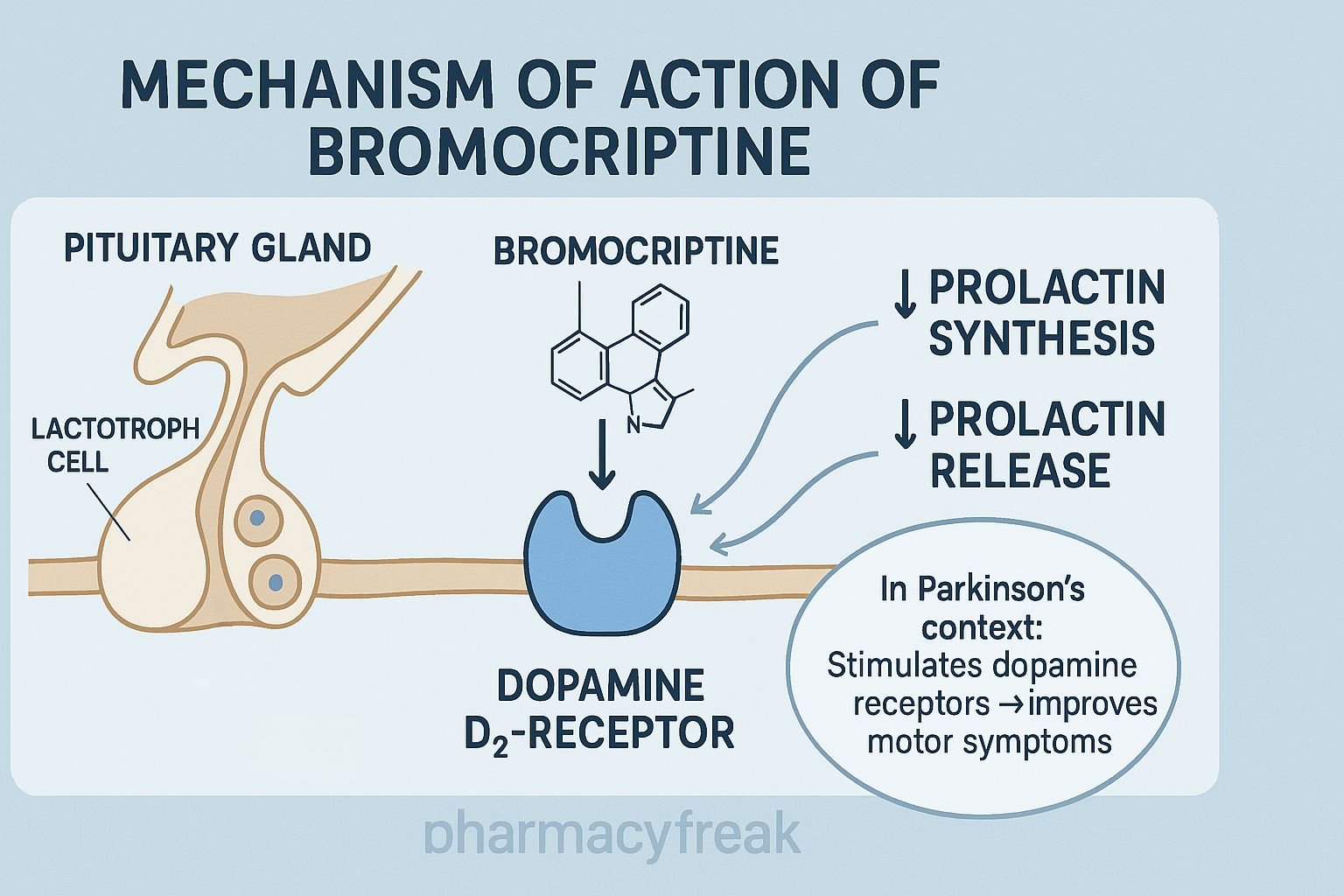Table of Contents
Introduction
Bromocriptine is a dopamine D2 receptor agonist used in the treatment of Parkinson’s disease, hyperprolactinemia, acromegaly, and type 2 diabetes mellitus (bromocriptine-QR). As an ergot-derived dopamine agonist, it mimics the action of dopamine on pituitary and central nervous system receptors.
Its mechanism of action involves inhibiting prolactin secretion, activating dopaminergic pathways, and modulating hypothalamic neurotransmitter rhythms, depending on the clinical indication. Bromocriptine is one of the earliest dopamine agonists with a long track record of therapeutic benefit.


Mechanism of Action (Step-wise)
1. Dopamine D2 Receptor Agonism – Primary Mechanism
Bromocriptine selectively stimulates D2 receptors in:
- Anterior pituitary lactotrophs
- Hypothalamic neurons
- Nigrostriatal pathway (Parkinson’s disease)
This mimics endogenous dopamine activity.
2. Inhibition of Prolactin Secretion
Under normal physiology, dopamine acts as prolactin-inhibitory factor (PIF).
Bromocriptine → D2 activation on lactotrophs →
- ↓ Prolactin synthesis
- ↓ Prolactin release
Effect: Treatment of hyperprolactinemia, galactorrhea, and prolactinomas.
3. Dopaminergic Activity in Parkinson’s Disease
Parkinson’s disease involves loss of dopaminergic neurons in the substantia nigra.
Bromocriptine → D2 stimulation in striatum →
- ↑ Dopaminergic signaling
- ↓ Excess acetylcholine activity
- ↓ Motor symptoms (tremor, rigidity, bradykinesia)
- Useful as levodopa adjunct therapy
4. Suppression of Growth Hormone in Acromegaly
Bromocriptine inhibits GH secretion by:
- Activating D2 receptors on somatotrophs
- Reducing GH production and release
Most effective in patients with mixed GH–prolactin secreting tumors.
5. Metabolic Effects in Type 2 Diabetes (Bromocriptine-QR)
Bromocriptine resets hypothalamic dopaminergic activity disrupted in metabolic syndrome.
Mechanisms include:
- ↑ Dopamine in early morning hypothalamus
- ↓ Sympathetic tone
- ↓ Hepatic gluconeogenesis
- ↑ Insulin sensitivity
Effect: Lower postprandial glucose and HbA1c.
6. Summary of Mechanism
| Mechanism | Target | Effect |
|---|---|---|
| D2 agonism | Pituitary | ↓ Prolactin |
| D2 agonism | Basal ganglia | ↓ Parkinsonian symptoms |
| D2 activation | Somatotrophs | ↓ Growth hormone |
| Hypothalamic reset | CNS | Improved insulin sensitivity, ↓ glucose |
Pharmacokinetics
- Absorption: Variable oral absorption
- Bioavailability: <10% due to first-pass metabolism
- Metabolism: Hepatic (CYP3A4)
- Half-life: 6–8 hours
- Elimination: Biliary/fecal
Clinical Uses
- Hyperprolactinemia
- Prolactinomas
- Parkinson’s disease
- Acromegaly (adjunct)
- Type 2 diabetes mellitus (bromocriptine-QR)
- Suppression of lactation (rarely now)
Adverse Effects
- Nausea and vomiting
- Orthostatic hypotension
- Headache
- Dizziness
- Fatigue
- Psychosis (rare, dose-related)
- Nasal congestion
- Vasospasm (ergot-related)
- Impulse-control disorders (dopamine agonist class effect)
Contraindications
- Uncontrolled hypertension
- Severe cardiovascular disease
- Pregnancy (for Parkinson’s use)
- Postpartum hypertension or preeclampsia
- Psychotic disorders
Comparative Analysis
| Feature | Bromocriptine | Cabergoline | Pramipexole |
|---|---|---|---|
| Receptor affinity | D2 selective | Potent D2 | D2/D3 |
| Duration | Short | Long | Long |
| Hyperprolactinemia efficacy | Good | Excellent | Low |
| Parkinson’s use | Yes | Limited | Strong |
| Dosing | Multiple daily | Once/twice weekly | Once/twice daily |
MCQs
1. Bromocriptine reduces prolactin secretion by:
a) Blocking dopamine receptors
b) Stimulating D2 receptors
c) Increasing serotonin levels
d) Stimulating GH receptors
Answer: b) Stimulating D2 receptors
2. Bromocriptine is used in Parkinson’s disease because it:
a) Inhibits MAO-B
b) Increases acetylcholine
c) Mimics dopamine at D2 receptors
d) Blocks glutamate
Answer: c) Mimics dopamine at D2 receptors
3. In type 2 diabetes, bromocriptine works by:
a) Increasing insulin secretion
b) Reducing sympathetic tone and hepatic glucose output
c) Blocking GLP-1 degradation
d) Stimulating pancreatic beta cells
Answer: b) Reducing sympathetic tone and hepatic glucose output
4. Major adverse effect of bromocriptine:
a) Pulmonary fibrosis
b) Severe nausea and orthostatic hypotension
c) Nephrotoxicity
d) Myelosuppression
Answer: b) Severe nausea and orthostatic hypotension
5. Bromocriptine inhibits secretion of:
a) Aldosterone
b) Insulin
c) Prolactin
d) Catecholamines
Answer: c) Prolactin
FAQs
Q1. Can bromocriptine shrink prolactinomas?
Yes—by inhibiting prolactin secretion and cell growth.
Q2. Is bromocriptine safe during pregnancy?
It may be continued for prolactinoma under specialist supervision.
Q3. Does bromocriptine improve fertility?
Yes—by normalizing prolactin levels and restoring ovulation.
Q4. Can bromocriptine cause psychiatric effects?
Rarely, it may cause hallucinations or impulsive behaviors.
Q5. Is bromocriptine still used for lactation suppression?
Rarely, due to cardiovascular risks.
References
Goodman & Gilman’s Pharmacological Basis of Therapeutics
https://accesspharmacy.mhmedical.com/book.aspx?bookid=2189
Katzung: Basic and Clinical Pharmacology
https://accessmedicine.mhmedical.com/book.aspx?bookid=2464
Tripathi: Essentials of Medical Pharmacology
https://jaypeebrothers.com/
Harrison’s Principles of Internal Medicine
https://accessmedicine.mhmedical.com/book.aspx?bookid=2129

I am pursuing MBA in pharmaceutical management from NIPER Hyderabad with a strong academic record and proven success in national-level pharmacy entrance exams. I secured AIR 61 in NIPER 2024 (MS/M.Pharm) and AIR 27 in NIPER MBA, along with AIR 147 in GPAT 2024 and AIR 907 in GPAT 2023. I also achieved AIR 6 in AIIMS CRE-2025 for Drug Store Keeper and was selected as a Pharmacist (AIR 61) for ESIC. Additionally, I was the Runner-Up in Round 2 of the EY Case Study Competition.
At PharmacyFreak.com, I aim to guide future pharmacists through expert content, exam strategies, and insightful resources based on real experience and academic excellence.
Mail- harsh@pharmacyfreak.com
